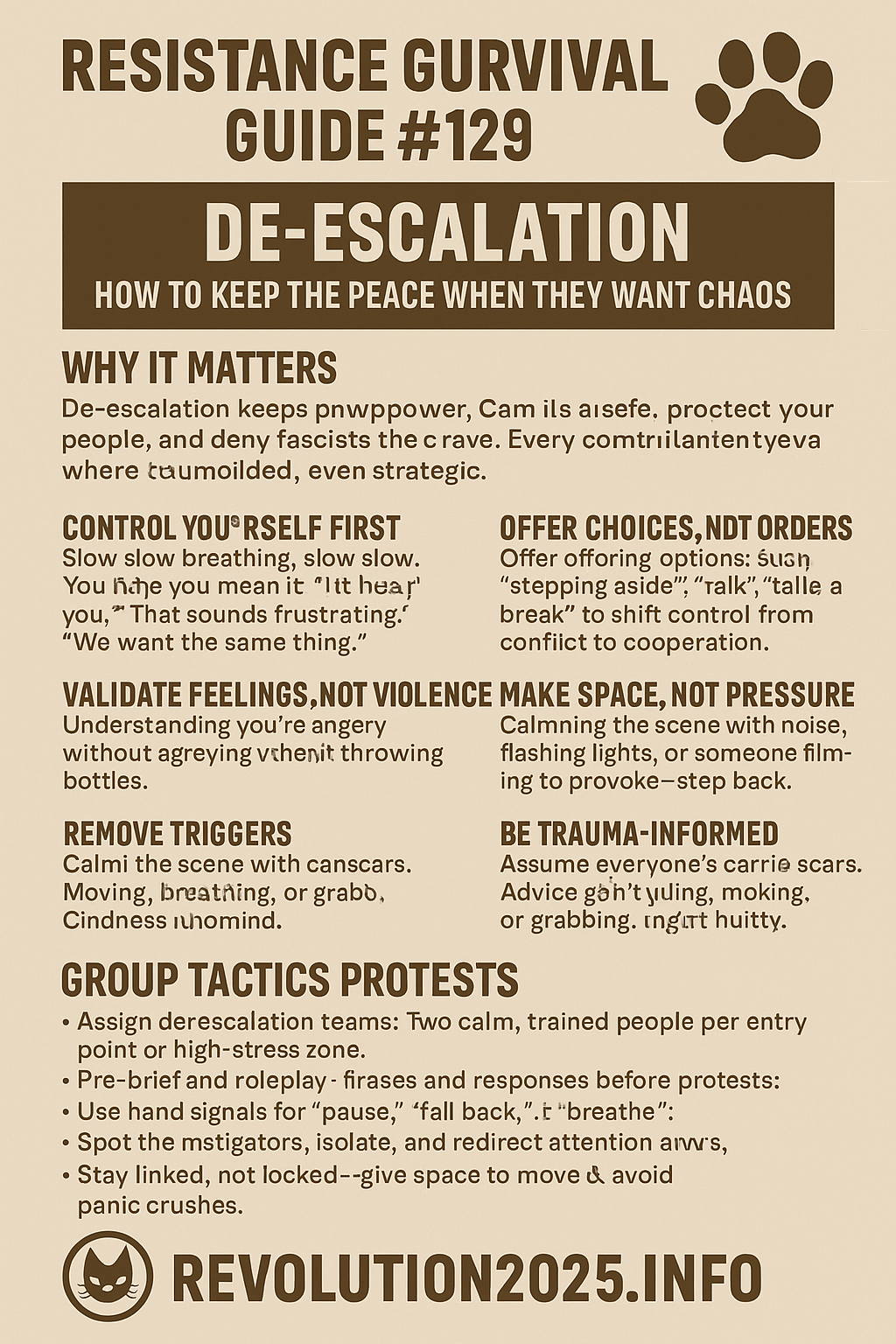Skill Level: Beginner
Why It Matters
When tensions rise, calm is a superpower.
De-escalation keeps protests safe, protects your people, and denies fascists the footage they crave. Every confrontation they bait you into becomes propaganda. Every calm, unified crowd they can’t provoke becomes a movement.
De-escalation isn’t surrender — it’s strategy. It’s how you protect your message, your community, and your right to keep fighting tomorrow.
Tools for the Calm Revolution
🐾 1. Control Yourself First
You can’t calm chaos if you’re radiating it. Breathe slow, talk slow, move slow. Keep your voice lower than the person shouting. Calm spreads faster than rage when modeled.
🐾 2. Listen Like You Mean It
Sometimes people just want to be heard. Use reflective language — “I hear you,” “That sounds frustrating,” “We want the same thing.” It lowers walls and slows adrenaline.
🐾 3. Validate Feelings, Not Violence
You can say “I understand you’re angry” without agreeing with throwing bottles. Validation makes people feel seen, not challenged.
🐾 4. Use “I” Statements
Avoid “You’re wrong” or “You need to.” Try: “I’m worried this could escalate.” It’s humanizing and disarms hostility.
🐾 5. Offer Choices, Not Orders
“Want to step aside to talk?” or “Want to take a break?” gives people agency. It shifts control from conflict to cooperation.
🐾 6. Make Space, Not Pressure
Physical distance cools emotional fire. Step back, gesture open palms, and never corner someone — it’s primal psychology.
🐾 7. Remove Triggers
If there’s noise, flashing lights, or someone filming to provoke — move the energy elsewhere. Calm the scene, not the camera.
🐾 8. Slow the Tempo
Move, breathe, and speak in half-speed. It pulls everyone’s nervous system back toward baseline.
🐾 9. Be Trauma-Informed
Assume everyone’s carrying scars. Don’t yell, mock, or grab. Kindness under stress is revolutionary.
🐾 10. Know When to Step Away
De-escalation is for preventable tension — not active danger. If someone’s violent or armed, step back and get help. You’re no good to the movement injured.
Group Tactics for Protests
- Assign De-Escalation Teams: Two calm, trained people per entry point or high-stress zone.
- Pre-Brief and Roleplay: Practice phrases and responses before protests.
- Use Hand Signals: Create gestures for “pause,” “fall back,” and “breathe.”
- Spot the Instigators: If someone’s trying to provoke, isolate and redirect attention away.
- Stay Linked, Not Locked: Give yourself space to move and avoid panic crushes.
- Debrief Afterward: Discuss what worked, what didn’t, and how to improve group response.

Call to Action
- Host a 10-minute mini-training on de-escalation before your next protest.
- Share this guide in your local resistance chats.
- Create calm cards — pocket-sized reminders of key phrases and breathing cues.
- Support trauma-informed mental health groups in your community — they keep the resistance grounded.
- Remember: every time you stay calm under pressure, you win twice — once for safety, once for strategy.
Kitty’s Final Word
They want us angry, reactive, divided. We’ll give them calm, unity, and focus. Revolution doesn’t always roar — sometimes it purrs, waiting for the perfect moment to strike. Stay cool, stay kind, stay claws-ready.

